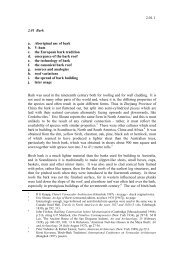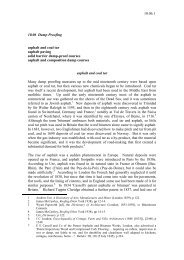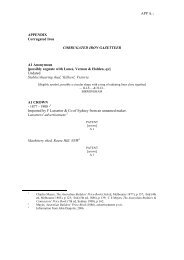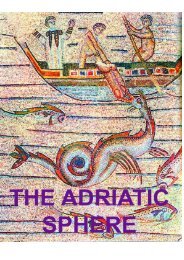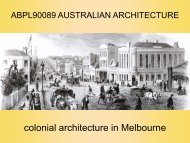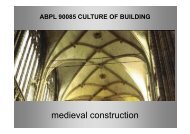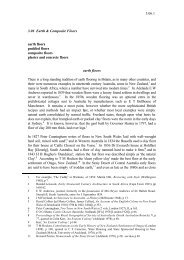the Ancient Near East - Miles Lewis
the Ancient Near East - Miles Lewis
the Ancient Near East - Miles Lewis
You also want an ePaper? Increase the reach of your titles
YUMPU automatically turns print PDFs into web optimized ePapers that Google loves.
ABPL90267 Development of Western Architecture<br />
<strong>the</strong> <strong>Ancient</strong> <strong>Near</strong> <strong>East</strong>
COMMONWEALTH OF AUSTRALIA<br />
Copyright Regulations 1969<br />
Warning<br />
This material has been reproduced and communicated to you<br />
by or on behalf of <strong>the</strong> University of Melbourne pursuant to Part<br />
VB of <strong>the</strong> Copyright Act 1968 (<strong>the</strong> Act).<br />
The material in this communication may be subject to copyright<br />
under <strong>the</strong> Act. Any fur<strong>the</strong>r copying or communication of this<br />
material by you may be <strong>the</strong> subject of copyright protection<br />
under <strong>the</strong> Act.<br />
do not remove this notice
some questions:<br />
what did people first live in?<br />
what were <strong>the</strong> first true buildings?<br />
when and where was an interior space,<br />
capable of holding groups of people, first<br />
constructed?<br />
when and where was <strong>the</strong> arch invented?
Gobekli Tepe, Turkey, c 9000 BC<br />
reconstruction of <strong>the</strong> circles; excavation plan<br />
web image : http://www.rinf.com/forum/showthread.php?p=24105
Göbekli Tepe, Turkey<br />
view of <strong>the</strong> pillared structure, auroch stele<br />
Antonio Sagona, The Heritage of <strong>East</strong>ern Turkey from Earliest Settlements to Islam<br />
(Macmillan Art Publishing, Melbourne 2006), p 38
house 47,<br />
Mureybet, Jordan,<br />
[phase III, 8 th<br />
millennium],<br />
excvated remains,<br />
and reconstruction<br />
drawing by G<br />
Deraprahamian.<br />
Thérèse Burollet et al, 1000<br />
Ans d’Art en Syrie<br />
[substantial exhibition<br />
publication] (Musée du Petit<br />
Palais, Paris 1983-4), p 41
model of a house at Mureybet, Jordan, c 8500 BC<br />
Flon, World Atlas of Archaeology, p 261
neolithic cultures<br />
c 6000-3000 BC<br />
(neolithic = new stone age)<br />
agriculture<br />
fixed settlements<br />
baked pottery<br />
buildings of mud brick, timber, reeds, rubble
<strong>the</strong> spread of agriculture<br />
Trump, Malta: Prehistory and Temples, p 54
sun-dried brick from Jericho, c 8,000 BC<br />
John Woodforde, Bricks to Build a House (London 1976), p 19
sun-dried bricks<br />
from Sialk, Iran, 6 th<br />
millennium BC<br />
A U Pope, Introducing Persian<br />
Architecture (Soroush Press,<br />
Tehran 1976 [1969]), p 7.
eehive dwellings, Cyprus, 6 th millennium BC<br />
MUAS 14,557
Tell Bouqras,<br />
eastern Syria, c<br />
6000 BC: plan<br />
Burollet, Art en<br />
Syrie, p 35
house at Çatal Höyük, Turkey, c 6000 BC<br />
<strong>Miles</strong> <strong>Lewis</strong>
‘Sanctuary<br />
VI’, Çatal<br />
Höyük, part<br />
reconstruction<br />
by James<br />
Mellaart<br />
Pierre Amiet, Art<br />
of <strong>the</strong> <strong>Ancient</strong><br />
<strong>Near</strong> <strong>East</strong> (Harry<br />
N Abrams, New<br />
York 1980 [1977]),<br />
p 572
supposed Çatal<br />
Höyük map, c<br />
6200 BC<br />
in situ and as<br />
reconstructed<br />
http://www.ancientwisdom.co.uk/turkeyc<br />
atalhuyuk.htm
Inside a model of a house<br />
at Catal Hüyük, by Stipich<br />
Béla<br />
Wikipedia Commons November 2011
Catal Höyük,<br />
reconstructions of <strong>the</strong><br />
decoration, by<br />
Mellaart<br />
second sanctuary<br />
of <strong>the</strong> vultures VII,<br />
sanctuary A-III,<br />
main room<br />
Pierre Amiet, Art of <strong>the</strong><br />
<strong>Ancient</strong> <strong>Near</strong> <strong>East</strong>, p 573
Mohenjo-Daro<br />
<strong>Lewis</strong>, Architectura, p 39
Mohenjo-Daro, Pakistan, c 2500-<br />
2000 BC aerial view of part of<br />
<strong>the</strong> citadel, street with limestone<br />
blocks over drains, great bath &c<br />
Christine Flon [ed], The World Atlas of<br />
Archaeology (London 1985), p 243
<strong>the</strong><br />
development<br />
of trade and<br />
literacy<br />
Egypt &<br />
Mesopotamia c<br />
2250 BC<br />
Colin McEvedy, The<br />
Penguin Atlas of <strong>Ancient</strong><br />
History (Harmondsworth<br />
[Middlesex]1967), p 27
<strong>the</strong> development of <strong>the</strong> fertile crescent<br />
towns trade and literacy in Egypt & Mesopotamia 2250 BC and 1300 BC<br />
Colin McEvedy, The Penguin Atlas of <strong>Ancient</strong> History (Harmondsworth [Middlesex]1967), pp 27, 35
<strong>the</strong> ancient near east<br />
Henri Frankfort, The Art and Architecture of <strong>the</strong> <strong>Ancient</strong> Orient (Harmondsworth [Middlesex] 1954), rear endpaper
EGYPT<br />
OLD KINGDOM 2680-2258<br />
MIDDLE KINGDOM 2134-1786<br />
NEW KINGDOM 1570-1085
<strong>the</strong> ancient sites in<br />
Lower and Upper<br />
Egypt, up to <strong>the</strong> First<br />
Cataract<br />
MUAS 14,517
Egyptian tombs<br />
pit<br />
stair mastaba<br />
shaft mastaba<br />
stepped pyramid<br />
pyramid
urials from <strong>the</strong> Naqada I, II & III periods, Egypt<br />
Samima Ikram, <strong>Ancient</strong> Egypt: an Introduction (Cambridge UP, Cambridge 2010), p 76
tomb of <strong>the</strong> artisan or<br />
servant class, 1 st Dynasty<br />
(3,200 - 2980), plan and<br />
section<br />
MUAS 14,380
<strong>the</strong> mastaba
mastabas at Giza<br />
MUAS 14,905
estoration of part of <strong>the</strong> necropolis at Giza<br />
George Perrot & Charles Chipiez, Histoire de l’Art dans l’Antiquité. Tome Premier: l’Égypte (Hachette, Paris 1882), p 174
section of a typical Old Kingdom mastaba<br />
Samima Ikram, <strong>Ancient</strong> Egypt:an Introduction<br />
(Cambridge UP, Cambridge 2010), p 288
cross-section of a shaft mastaba of <strong>the</strong> Old Kingdom<br />
'Samivel' [pseudonym], The Glory of Egypt (London 1955), p 209
Tomb 3038, Saqqara, Dynasty I, time of <strong>the</strong> sixth king, Az-ib, c 3,200-2980<br />
W S Smith, The Art and Architecture of <strong>Ancient</strong> Egypt (Harmondsworth [Middlesex] 1965 [1958]), pl 8
econstruction of a royal tomb at Saqqara of <strong>the</strong> First Dynasty (c 3100 BC)<br />
Jean-Louis de Cenival, Egypt (Benedikt Taschen, Köln, no date), p 11
<strong>the</strong> stepped pyramid
Sekhem-Ket Zoser<br />
Baines, Atlas of <strong>Ancient</strong> Egypt, p 144<br />
<strong>the</strong> evolution of <strong>the</strong><br />
stepped pyramid<br />
at Saqqara<br />
Tomb 2038<br />
c 3200-2980<br />
(not shown)<br />
<strong>the</strong> Zoser complex<br />
c 2778<br />
Pyramid of Sekhem-Ket<br />
c 2700
Zoser complex at Saqqara, by Imhotep, Dynasty III, c 2,778, reconstruction<br />
Baines, Atlas of <strong>Ancient</strong> Egypt, pp 138-9
Zoser Pyramid: stages of construction<br />
http://www.arthistory.upenn.edu//zoser/zoser.html (modified)
Stepped pyramid of Zoser, Saqqara, by Imhotep c 2778 BC<br />
<strong>Miles</strong> <strong>Lewis</strong>
Pyramid of Sekhem-khet at Saqqara, c 2,700 B C, section<br />
MUAS 14,391
<strong>the</strong> true pyramid
<strong>the</strong> Bent Pyramid, Dahshur, c 2650 BC<br />
Jean-Louis de Cenival, Egypt (Benedikt Taschen, Köln, no date), p 45
Khufu (or Cheops)<br />
Mykerinus<br />
Khafra (or Chephren)<br />
<strong>the</strong> Pyramids at Giza, all Dynasty IV (c 2,600<br />
B C) aerial reconstruction<br />
Ian Westwell & Robin Pereira, <strong>Ancient</strong> Monuments Revealed (Chartwell Books,<br />
Edison [New Jersey] 2006) p 17
The Pyramids at Giza all Dynasty IV (c 2,600 B C): Great Pyramid of Khufu (or Cheops); Khafra (or<br />
Chephren; Mycerinus (last of <strong>the</strong> three), with mastabas in <strong>the</strong> foreground<br />
Henri Stierlin, Notre Histoire Lue du Ciel: Monuments de l'Antiquité (Paris 2005), no page
Pyramid of Khafra<br />
(Chephren), with Sphinx<br />
MUAS 8,800<br />
Pyramid of Khufu<br />
(Cheops), close view from<br />
north-west<br />
<strong>Miles</strong> <strong>Lewis</strong>
Pyramid of Khufu (Cheops), section<br />
Jean-Louis de Cenival, Egypt (Benedikt Taschen, Köln, no date), p 46
chambers of <strong>the</strong><br />
Great Pyramid,<br />
section<br />
Ian Westwell & Robin<br />
Pereira, <strong>Ancient</strong><br />
Monuments Revealed<br />
(Chartwell Books, Edison<br />
[New Jersey] 2006), p 23
Pyramid of Khufu (Cheops): <strong>the</strong> King’s chamber<br />
Henry Stierlin, Encyclopædia of World Architecture (2 vols, London 1977), I, p 24
chambers of <strong>the</strong> Great<br />
Pyramid, axonometric<br />
Westwell & Pereira, <strong>Ancient</strong><br />
Monuments Revealed, p 23
vegetable influences<br />
in Egyptian architecture<br />
rush<br />
papyrus<br />
palm<br />
lotus (waterlily)
Zoser Complex, Saqqara, by Imhotep, c 2,778:<br />
reconstructed wall and entrance gate<br />
<strong>Miles</strong> <strong>Lewis</strong>
Zoser Complex,<br />
underground chamber:<br />
imitation of rush mat wall<br />
and door roll<br />
Wooden false door of <strong>the</strong><br />
Stela of Ika, from Saqqara,<br />
c 2400 BC<br />
S14,596<br />
Alessandro Bongioanni et al [eds], The<br />
Illustrated Guide to <strong>the</strong> Egyptian<br />
Museum in Cairo (Cairo 2001), p 73
naos which contained<br />
a statue of Osiris,<br />
region of Lake Mariout<br />
near Alexandria,<br />
Egypt, c 570-526 BC:<br />
Musée du Louvre,<br />
Paris<br />
<strong>Miles</strong> <strong>Lewis</strong>
Zoser colonnade & pyramid<br />
<strong>Lewis</strong>, Architectura, p 242
Zoser colonnade as reconstructed<br />
<strong>Lewis</strong>, Architectura, pp 242-3
entrance hall of <strong>the</strong> Zoser<br />
complex<br />
detail of a spur wall and<br />
reconstruction view<br />
<strong>Miles</strong> <strong>Lewis</strong><br />
Smith, Art and Architecture of <strong>Ancient</strong> Egypt, pl 17B
palm log roofing<br />
imitated in stone<br />
Zozer complex,<br />
Saqqara, Egypt<br />
House of <strong>the</strong> South<br />
Entrance Hall<br />
<strong>Miles</strong> <strong>Lewis</strong>
Zoser complex: <strong>the</strong> Great South Court (or Heb Sed Court)<br />
with reconstructed buildings on <strong>the</strong> west side<br />
<strong>Miles</strong> <strong>Lewis</strong>
Ma'Dan reed house, Iraq<br />
under construction & complete<br />
MUAS 7014, 7,016<br />
comparison with <strong>the</strong> buildings of <strong>the</strong> Heb-<br />
Sed Court, Zoser complex, Saqquara
papyrus plants<br />
Knight, Dictionary of Mechanics, II, p 2604; <strong>Miles</strong> <strong>Lewis</strong>
Zoser complex, engaged columns with papyrus capitals<br />
papyrus plants on <strong>the</strong> Nile<br />
<strong>Miles</strong> <strong>Lewis</strong>; Knight, Dictionary of Mechanics
papyrus frescoes from Amarna, now in<br />
<strong>the</strong> Egyptian Museum, Cairo<br />
<strong>Miles</strong> <strong>Lewis</strong>
Egyptian columns of <strong>the</strong> Dynastic period<br />
papyriform (papyrus bundle with closed heads);<br />
bell-shaped (single papyrus stem with open head); palm<br />
McKenzie, Architecture of Alexandria and Egypt , p 122
evolution of closed papyrus bud columns in Egypt<br />
Jean-Louis de Cenival, Egypt (Benedikt Taschen, Köln, no date), p 181
closed papyrus bud capitals<br />
column from Méoamoud, reign of Sébekhotep<br />
III, c 1750-1700 BC, Louvre, Paris<br />
capital from Luxor, XVIII Dynasty (c 1600-<br />
1300)<br />
<strong>Miles</strong> <strong>Lewis</strong><br />
MUAS 14,916
Wooden model of <strong>the</strong> pavilion of Meket-Ra, XI Dynasty (2134-1991), Egyptian museum, Cairo<br />
<strong>Miles</strong> <strong>Lewis</strong>
comparative Egyptian columns<br />
Banister Fletcher, A History of Architecture on <strong>the</strong> Comparative Method (17th ed, London 1961 [1896]), p 55
Deir el-Bahari
Deir el Bahari, aerial view of <strong>the</strong> Temple of Mentuhotep and <strong>the</strong> Temple of Hatshepsut<br />
Henri Stierlin, Notre Histoire Lue du Ciel: Monuments de l'Antiquité (Paris 2005), no page
mortuary temple of Mentuhotep, Deir el Bahari,c 2100 BC<br />
alternative reconstructions<br />
Samima Ikram, <strong>Ancient</strong> Egypt: an Introduction (Cambridge UP, Cambridge 2010), p 143
mortuary temple of Mentuhotep, Deir el Bahari,<br />
c 2,100: reconstruction<br />
MUAS 9,931
Temple of Hatshepsut, Deir el Bahari, by Senmut, Dynasty XVIII (c 1500 BC)<br />
MUAS 14,371
Hatshepsut’s Mortuary or<br />
Memorial Temple, by Senenmut,<br />
c 1500 BC, plan<br />
Samima Ikram, <strong>Ancient</strong> Egypt: an<br />
Introduction (Cambridge UP,<br />
Cambridge 2010), p 144
plan of <strong>the</strong><br />
Middle<br />
Kingdom<br />
temple at Tod<br />
Samima Ikram, <strong>Ancient</strong><br />
Egypt: an Introduction<br />
(Cambridge UP,<br />
Cambridge 2010), p 131
typical New Kingdom temple:<br />
pylon gate, courtyard, hypostyle hall, sanctuary<br />
Pemberton, <strong>Ancient</strong> Egypt, p 29
temple complex, Karnak Thebes (1,530-332 B C)<br />
view with <strong>the</strong> surviving elements restored, by Charles Chipier<br />
George Perrot & Charles Chipiez, Histoire de l’Art dans l’Antiquité. Tome Premier: l’Égypte (Hachette, Paris 1882), p 366
Great Temple of Amon at<br />
Karnak: plan<br />
first shrine c 2000 BC<br />
present complex c 1530-332 BC<br />
Pylons VII & VIII at right angles led<br />
to a Temple of Amenhotep I, c 1300<br />
Hypostyle hall, after 1300<br />
detached temple by Ramses II, later<br />
incorporated into <strong>the</strong> courtyard by<br />
Sheshonq I (950-929)<br />
first pylon later, never complete<br />
MUAS 9,394
Temple of Amon, Sphinx Avenue and temple entrance<br />
Rose-Marie & Rainer Hagen, Egypt: People, Gods, Paroahs (Taschen, Koln & London 1999), p 191
Temple of<br />
Amon,<br />
entrance<br />
Rose-Marie & Rainer<br />
Hagen, Egypt: People,<br />
Gods, Paroahs<br />
(Taschen, Koln &<br />
London 1999), p 188
Great Temple of Amon: axial view in <strong>the</strong> forecourt<br />
<strong>Miles</strong> <strong>Lewis</strong>
Great Temple of<br />
Amon<br />
Pillars set up by<br />
Tuthmosis III<br />
papyrus<br />
(symbolising Lower Egypt)<br />
lotus<br />
(symbolising Upper Egypt)<br />
MUAS 4,605
Temple of Amon, Pylon II, in a 19th century aquatint after an Egyptian relief<br />
Sigfried Giedion, Space, Time and Architecture: <strong>the</strong> Growth of a New Traditions (4th ed, Cambridge [Massachusetts] 1963), fig 240
Temple of Amon<br />
interior of <strong>the</strong> hypostyle hall<br />
<strong>Miles</strong> <strong>Lewis</strong>
Temple of Amon, hypostyle hall<br />
view and diagram of clerestory roof construction<br />
Henri Stierlin, Notre Histoire Lue du Ciel: Monuments de l'Antiquité (Paris 2005), no page<br />
de Cenival, Living Architecture: Egyptian, p 140
MESOPOTAMIA
MESOPOTAMIA<br />
<strong>the</strong> valley of <strong>the</strong> Tigris and <strong>the</strong> Euphrates rivers<br />
(within modern Iraq)<br />
Protoliterate c 3500-3000 BC<br />
Early dynastic c 3000-2340<br />
Neo-Sumerian c 2125-2025<br />
Isin-Larsa c 2025-1763<br />
Early Assyrian, c 1350-1000
map of Mesopotamia<br />
I L Finkel & M J Seymour [eds], Babylon: Myth and Reality (British Museum Press, London 2008), p 15
Abbadeh village (Al 'Ubaid), Iraq, c 4000 BC<br />
reconstruction by S Aboud<br />
Flon, World Atlas of Archaeology, p 169
'White' Temple of Anu at Uruk [Warka], view & plan<br />
Frankfort, Architecture of <strong>the</strong> <strong>Ancient</strong> Orient, pl I
temples dedicated to <strong>the</strong> god Anu, Uruk (or Warka),<br />
axonometric after E Heinrich, H J Lenzen & M J Schmidt<br />
Amiet, Art of <strong>the</strong> <strong>Ancient</strong> <strong>Near</strong> <strong>East</strong>, p 545
Painted Temple, Al 'Uqair, model<br />
MUAS 14,614
Nor<strong>the</strong>rn Temple, Tepe<br />
Gawra Acropolis, stratum<br />
XIII, 3rd millennium<br />
view & plan<br />
MUAS 14,612<br />
Frankfort, Architecture of<br />
<strong>the</strong> <strong>Ancient</strong> Orient, p 3
Temple at<br />
Khafaje, Early<br />
Dynastic period<br />
(3,000 - 2,340)<br />
Pierre Amiet, Art of <strong>the</strong><br />
<strong>Ancient</strong> <strong>Near</strong> <strong>East</strong><br />
(Harry N Abrams, New<br />
York 1980 [1977]), p<br />
531
Sumerian reed house, Al<br />
'Ubaid, diagram of wall<br />
construction<br />
Ma'Dan reed house, Iraq<br />
Plommer, <strong>Ancient</strong> and Classical<br />
Architecture, p 62<br />
MUAS 7,016
Statue of King Gudea<br />
from Telloh, c 2,100<br />
Musée du Louvre<br />
<strong>Miles</strong> <strong>Lewis</strong><br />
Gudea’s plan and a<br />
reconstruction of his<br />
instruments<br />
Plommer, <strong>Ancient</strong> and<br />
Classical Architecture, p 62
Temple of Ishtar-Kititum<br />
at Ischali, Isin-Larsa<br />
period, reconstructed<br />
view<br />
Frankfort, Architecture of <strong>the</strong> <strong>Ancient</strong><br />
Orient, p 54
Ishtar Temple of Tukulti-Ninurta I, Early Assyrian (c 1,350-<br />
1,000): reconstructed view<br />
Frankfort, Architecture of <strong>the</strong> <strong>Ancient</strong> Orient, pp 68-9
paired animals<br />
dado possible prototype for <strong>the</strong> an<strong>the</strong>mion and palmette<br />
Palace of Tukulti-Ninurta I, c 1,350 - 1,000: wall painting<br />
Frankfort, Architecture of <strong>the</strong> <strong>Ancient</strong> Orient, pp 68-9 , pl 74A<br />
rosettes
city of Ur: reconstruction model showing <strong>the</strong> Ziggurat, Palace, &c.<br />
MUAS 28,958
<strong>the</strong> Ziggurat at Ur, c 2000 BC: reconstruction<br />
Woolley, Excavations at Ur
Ziggurat at Ur, modern reconstruction<br />
<strong>Miles</strong> <strong>Lewis</strong> [ed], Architectura (Lane Cove [New South Wales] 2008), p 21
<strong>the</strong> ziggurat, Choga Zanbil [Dur Untash], Iran, C13th BC<br />
<strong>Miles</strong> <strong>Lewis</strong>
Choqa Zanbil ziggurat, initial state and with <strong>the</strong> ziggurat, after R Ghirshman<br />
Pierre Amiet, Art of <strong>the</strong> <strong>Ancient</strong> <strong>Near</strong> <strong>East</strong> (Harry N Abrams, New York 1980 [1977]), p 548
<strong>the</strong> ziggurat, Choga Zanbil, reconstruction view from <strong>the</strong> south<br />
R Ghirshman et al, Tchoga-Zanbil (Der-Untash) Volume I La Ziggurat [Memoires of <strong>the</strong> Mission<br />
Archéologique en Iran, vol xxxix) (Librairie Orientaliste Paul Geuthner, Paris 1966), frontispiece
<strong>the</strong> ziggurat,<br />
Choga<br />
Zanbil, plan<br />
R Ghirshman et<br />
al, Tchoga-Zanbil<br />
(Der-Untash)<br />
Volume I La<br />
Ziggurat<br />
[Memoires of <strong>the</strong><br />
Mission<br />
Archéologique en<br />
Iran, vol xxxix)<br />
(Librairie<br />
Orientaliste Paul<br />
Geuthner, Paris<br />
1966), inclusion
Choga Zanbil,<br />
inscribed bricks<br />
N Pourjavay [ed], The<br />
Splendour of Iran Volume I<br />
(Booth Clibborn Editions,<br />
London 2010 [2001), p 150
Choga Zanbil, passage<br />
and arch<br />
<strong>Miles</strong> <strong>Lewis</strong>
knobbed ceramic plaques C13th BC<br />
Haft Teppah Museum, Iran; Musée<br />
du Louvre, Paris<br />
Louvre SB 4601<br />
<strong>Miles</strong> <strong>Lewis</strong>; Pierre Amiet, Elam (Archée Éditeur,<br />
Auvers-sur-Oise 1966), p 354
fixing of ‘plaques de pommeau’<br />
Ghirshman, Tchoga-Zanbil I, p 75
house at Ur, c 1900 BC:<br />
section, plan & reconstructed<br />
view of courtyard<br />
Leonard Woolley, Ur of <strong>the</strong> Chaldees (Herbert<br />
Press, London 1982), pp 199, 198<br />
Plommer, <strong>Ancient</strong> and Classical Architecture, p 63
house at Lagash, Isin<br />
Larsa period (2025-<br />
1594): plan<br />
house at Dura-Europos,<br />
A D c 230, axonometric<br />
view<br />
MUAS 14,621<br />
Jean Lassus, The Early Christian and<br />
Byzantine World (London 1967), p 10



